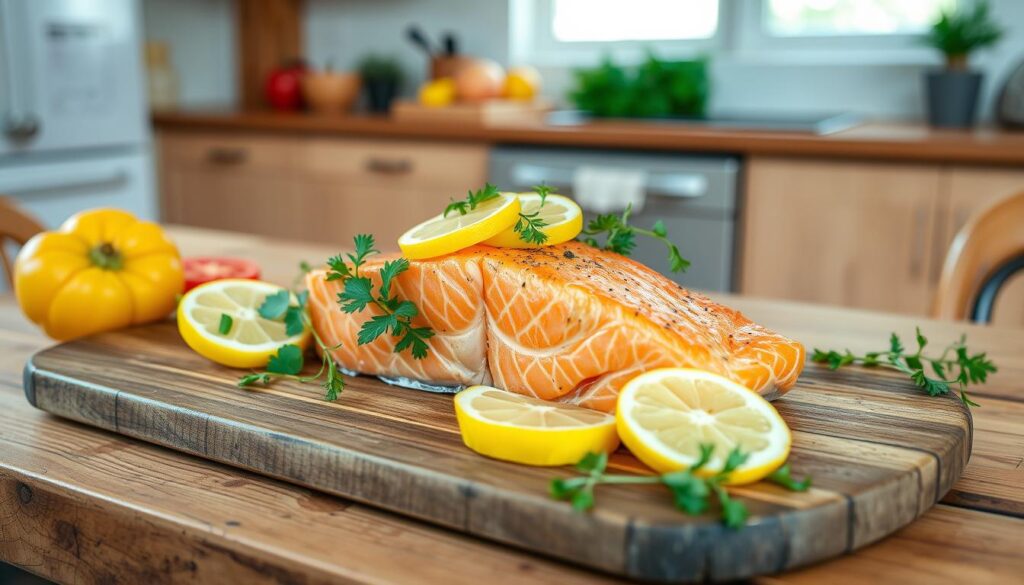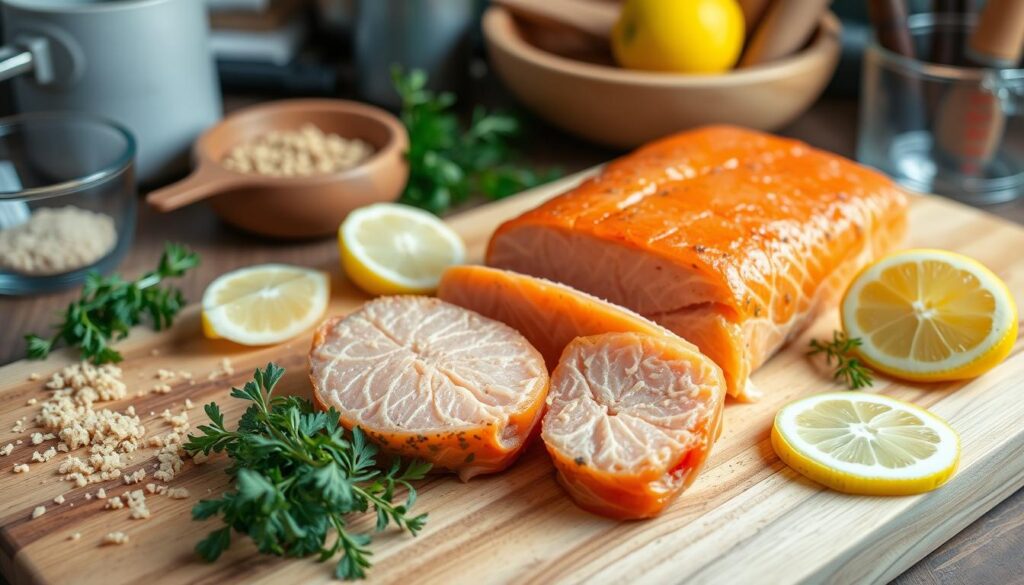As the sun set, my kitchen filled with the smell of salmon and spices. Cooking connects me to my roots. This easy salmon loaf recipe brought back memories of my grandmother’s cooking.
This salmon loaf recipe is a true gem. It’s quick, easy, and delicious. It’s perfect for both seasoned cooks and beginners. Its savory flavors and texture make it a crowd-pleaser.
I love how versatile this recipe is. You can find affordable salmon trimmings at stores like Food Basics. It’s also a healthy choice for those with Type 1 Diabetes. With a prep time of just 30 minutes, it’s ideal for busy weeknights.
Benefits of Making Salmon Loaf at Home
Salmon loaf is a great dish for those wanting to eat healthier. It’s not only budget-friendly but also quick to make. This makes it perfect for a quick dinner recipe at home.
Health Advantages of Salmon-Based Dishes
Salmon is packed with protein, about 22-25 grams in every 3.5-ounce serving. It’s also full of omega-3 fatty acids, with wild salmon having 2.2 grams and farmed salmon having 2.3 grams per 3.5-ounce portion. Plus, it’s rich in vitamins and minerals like vitamin B12 and selenium.
Cost-Effective Meal Solution
Salmon loaf is affordable, especially when you use canned salmon. Canned salmon is convenient, versatile, and nutritious. It’s a great choice for making a tasty and healthy dish without spending a lot.
Time-Saving Dinner Option
Making a salmon loaf at home is quick, taking under 30 minutes. Its simple ingredients and easy preparation make it ideal for busy nights or when you need a fast meal.
Essential Ingredients for Perfect Salmon Loaf
To make a tasty salmon loaf at home, you need a few key ingredients. Start with 2 pounds of salmon fillet. You can find antibiotic-free salmon at stores like Costco for just $7.49 per pound. This makes it a great choice for your budget.
Next, gather salt, pepper, diced sautéed onion, breadcrumbs or almond meal for a gluten-free version, chopped fresh parsley, mayonnaise or Greek yogurt, Dijon mustard, beaten egg, and lemon juice. These ingredients mix to give your canned salmon recipe the perfect taste and texture.
| Ingredient | Quantity |
|---|---|
| Salmon Fillet | 2 pounds |
| Salt | To taste |
| Black Pepper | To taste |
| Onion, diced and sautéed | 1 cup |
| Breadcrumbs or Almond Meal | 1 1/2 cups |
| Fresh Parsley, chopped | 1/2 cup |
| Mayonnaise or Greek Yogurt | 1/2 cup |
| Dijon Mustard | 2 tablespoons |
| Eggs, beaten | 2 large |
| Lemon Juice | 2 tablespoons |
With these salmon loaf ingredients ready, you’re set to make a delicious canned salmon recipe. It’s sure to please everyone in your family.
“The key to a perfect salmon loaf is using high-quality, fresh salmon and balancing the flavors with the right combination of herbs, spices, and binders.”
Step-by-Step Salmon Loaf Recipe
Making a tasty salmon loaf at home is simple. It’s perfect for a cozy meal or to add healthy salmon to your diet. Follow these steps to make a delicious salmon loaf.
- Preheat your oven to 400°F (200°C).
- Rinse the salmon fillets and pat them dry. Season with salt and black pepper.
- Put the seasoned salmon on a baking sheet and bake for 15 minutes. Let it cool for 5 minutes. Then, flake the fish into small pieces.
- In a big mixing bowl, mix the flaked salmon with 1/2 cup of finely diced yellow onion, 3 tablespoons of Panko breadcrumbs, one egg, 2 tablespoons of mayonnaise, 1 tablespoon of whipped cream cheese, 1 tablespoon of fresh lemon juice, 1 teaspoon of low-sodium soy sauce, 1/2 teaspoon of garlic powder, and a pinch of salt and black pepper.
- Mix everything well. If it’s too dry, add another tablespoon of mayonnaise.
- Grease a loaf pan with cooking spray or butter. Put the salmon mixture in the pan and shape it into a loaf.
- Bake the salmon loaf for 15-20 minutes. It should be golden brown on top and warm inside.
For a tasty twist, serve the salmon loaf with a spicy sauce. Mix 1/4 cup of mayonnaise, 2 tablespoons of sriracha, and 1 teaspoon of low-sodium soy sauce. You can also add maple syrup to sweeten it.
This salmon loaf recipe is great for any meal. It’s sure to be a hit with your family. Enjoy!

Tips for Selecting the Best Salmon
Choosing the right salmon is key to making a great salmon loaf. Whether you pick fresh or canned salmon, there are important things to look for. This ensures you get the best ingredient for your dish.
Fresh vs Canned Salmon Options
Fresh salmon gives you the best taste and nutrition. Look for fillets that are firm and brightly colored. They should also have no strong fish smell. Canned salmon is a good choice when fresh is hard to find. Make sure it’s wild-caught for better nutrition.
Quality Indicators to Look For
- Fresh salmon should have a vibrant, glossy appearance with no discoloration or brown spots.
- The flesh should feel firm and slightly springy to the touch, not mushy or soft.
- Canned salmon should be packed in water or oil, and the cans should be free of dents or bulges.
- For a more budget-friendly option, consider salmon trimmings, which can be just as flavorful as the fillet.
By following these tips when choosing salmon, you’ll make a tasty and healthy salmon loaf. Your family will surely enjoy it.
Common Mistakes to Avoid
Making a tasty salmon loaf needs careful attention and avoiding common mistakes. One big mistake is overmixing the salmon mix. This can make the loaf dense and unappealing. Instead, mix the ingredients gently until they just come together.
Another mistake is not letting the loaf rest after baking. This step is crucial for the loaf to firm up and flavors to blend. Make sure to let it rest for 10-15 minutes before slicing and serving.
Seasoning is also important to avoid a bland salmon loaf. Make sure to add the right amount of salt, pepper, and herbs or spices. Taste the mix before baking to adjust if needed.
Lastly, don’t overbake the salmon loaf. This can dry it out and ruin the moist texture you want. Keep an eye on the oven. Remove the loaf when the top is golden and a toothpick comes out clean, usually in 45-50 minutes.

By avoiding these mistakes, you’ll make a delicious salmon loaf. Your family and friends will surely enjoy it.
Serving Suggestions and Pairings
A homemade salmon loaf is more than just a main dish. It’s a canvas for a variety of side dishes and sauces. These can bring out the rich flavors of the salmon.
Complementary Side Dishes
Side dishes offer endless options. Try pairing the salmon loaf with roasted sweet potatoes, farro salad, or a quinoa and chickpea medley. These choices add nutrients and balance out the dish.
For a lighter option, a lemon kale salad or vegetable risotto can highlight the salmon’s taste. Classic sides like mashed potatoes or fluffy rice pilaf also work well, adding a comforting touch.
Sauce Recommendations
Adding a sauce like Sriracha Lemon Aioli can elevate your salmon loaf. This sauce combines mayonnaise, Sriracha, lemon juice, garlic, salt, and pepper. It’s tangy, creamy, and spicy, balancing the salmon’s richness.
For something simpler, try a lemon dill sauce or garlic butter sauce. These sauces enhance the salmon’s taste without overpowering it.
Pairing your salmon loaf with the right sides and sauces makes for a satisfying meal. Don’t be afraid to experiment with flavors to find your favorite combination.
Storage and Reheating Guidelines
Storing and reheating your homemade salmon loaf right is key to enjoying it fully. To store leftovers, put them in an airtight container and keep them in the fridge for up to 3 days. When you’re ready to eat it again, preheat your oven to 350°F (175°C). Bake the salmon loaf for about 10 minutes, or until it’s hot and reaches 165°F (74°C) as the USDA suggests.
If your salmon loaf is frozen, thaw it in the fridge overnight. Then, bake it at 400°F (205°C) for 15-20 minutes. Make sure it reaches 165°F (74°C) inside. You can also reheat it in an air fryer for 5-10 minutes, watching the temperature closely.
Reheating in the microwave? Use medium power (50-70%) and check the temperature often. This prevents overcooking or drying out. The goal is to keep it moist and reach 165°F (74°C) inside. By following these tips, you can enjoy your salmon loaf many times.










